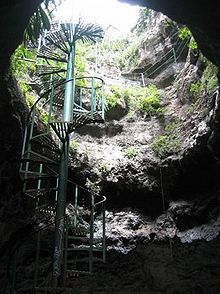- Cuexcomate
-
Cuexcomate is an inactive volcano in Puebla city, Puebla state, Mexico. It stands at 13 metres (43 feet) with a diameter of 23 metres (75 feet) and is thought to be the smallest volcano on Earth.[1][2]
The volcano was formed in 1064 by an eruption of the Popocatépetl, an active volcano and the second highest peak in Mexico. There is a metal spiral staircase that allows tourists to descend into the volcano.
The name is from Nahuatl for "clay pot" or "place to keep". location: 19 04 14.02N, 98 14 06.92W
Contents
Characteristics
- Volcano Type: big
- Height: 13 meters.1metre
- Crater Diameter: 8 meters.
- Base Exterior Diameter: 23 meters.
- Weight: approx. 40 tons.
- Elevation: 13 meters.bo
- First Eruption: 1064
- Last Eruption: 1662
- Coordinates: 19°04′14.7″N 98°14′05.7″W / 19.07075°N 98.234917°W.
Description
A description of the Cuexcomate Volcano from the year 1585 says: "at one league from this city, close to the bridge that they call Cholula, there is in a large grassland... in circular shape, a rock of 6 or 7 estados high, at the top of which there is a great mouth as if it were made to hold a waterwheel. The which is very deep, and at the bottom of which there is foul smelling water, a very important thing to note: there they say that in the heathen days they threw in (indios) natives to be sacrificed to their idols."
The crater of Cuexcomate is an empty limestone cone of an extinct geyser.
History
It was formed by a burst of hydrogen sulfide geyser, and volcanic lava, as a chain reaction from the 1064 eruption of Popocatépetl, located in the town of La Libertad.
It was said that in ancient times, the people of Puebla threw the bodies of suicide victims into the crater, because they didn't deserve to be mourned or buried.
During this same time, the people living around the volcano were said to be 'children of the devil' or 'under the rule of the devil', because of Cuexcomate.
It is believed that of the various tunnels that cross under the city of Puebla, Puebla, one travels from the hill of Loreto to the hill of San Juan(now the hill of La Paz) and from there travels down to the hill Cuexcomate, afterward crossing under the Atoyac river and ending in the Archaeological zone of Cholula and its pyramids.
On March 11, 1943, the town of La Libertad was incorporated into the city of Puebla, Puebla.
In the chronology of historical events, on November 27, 1970 a plaque was placed to commemorate the founding of the town around the sides of the Cuexcomate volcano.
Tourism
The volcano is found between 2 Poniente (west) and 3 Norte (north), in the Colonia La Libertad, Puebla.
There are spiral metal stairs that allow one to descend to the interior of the crater.
The Taal volcano in the Philippines is the world's smallest, famous for being a volcano set in the middle of a lake in the middle of an island, but the Taal is only the smallest active volcano.
Technically, Cuexcomate is not a “real “ volcano because it was formed only as a geyser when Popocatépetl erupted.
See also
References
References
- ^ Peakware. "El Cuexcomate". Accessed 5 August 2006.
- ^ Traveling Well. "Traveling Well to Mexico". Accessed 5 August 2006.
Coordinates: 19°04′14″N 98°14′07″W / 19.07056°N 98.23528°W
Categories:- Volcanoes of Mexico
- Puebla (city)
Wikimedia Foundation. 2010.

